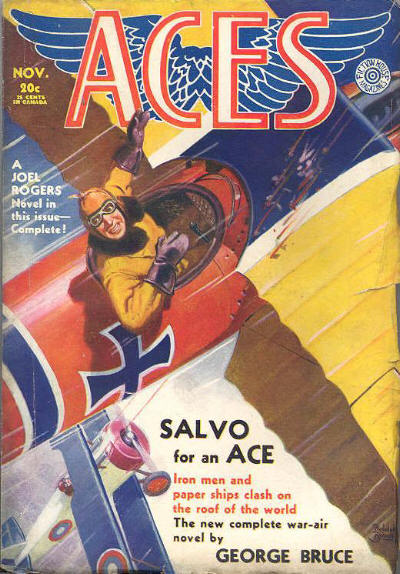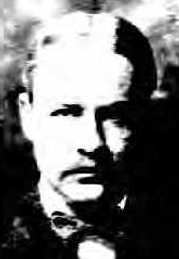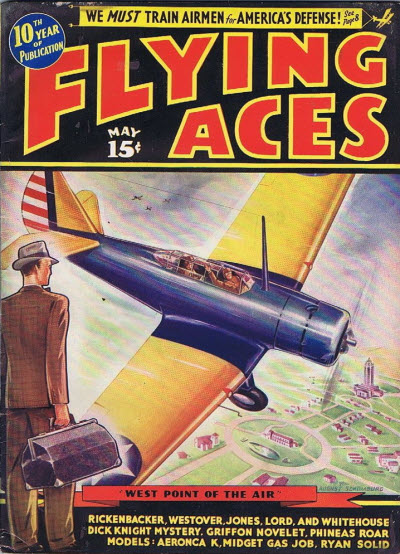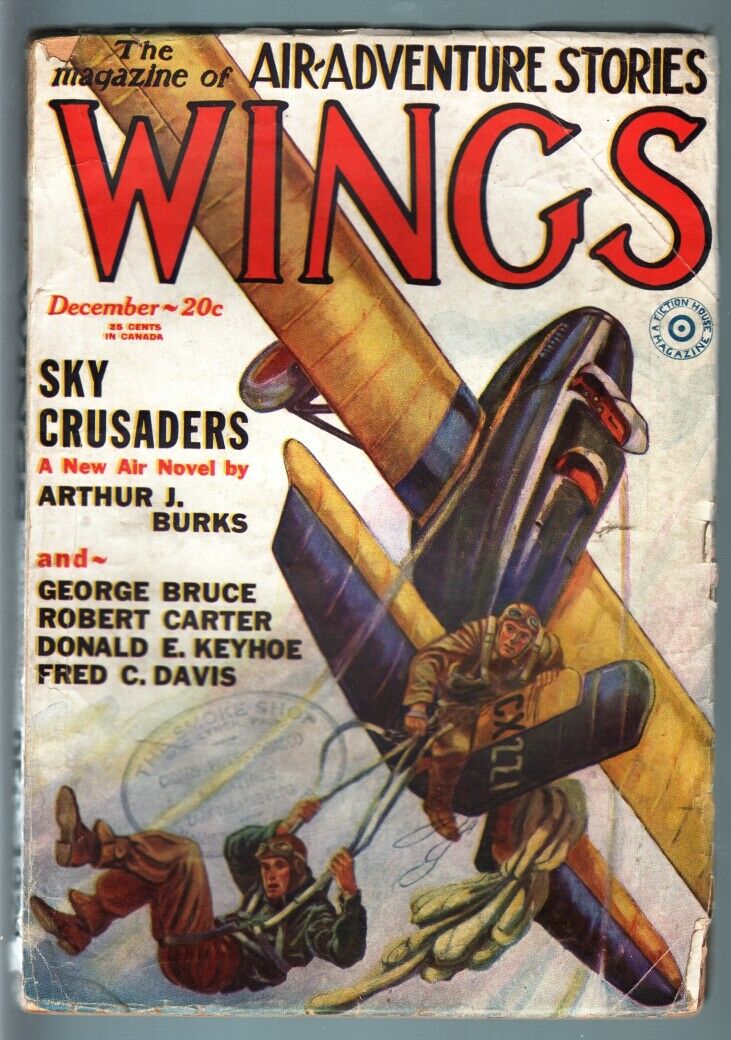THIS week we have a story  by H.P.S. Greene. Henry Paul Stevens Greene wrote aviation tales from the late 20’s to the early 40’s for magazines like Wings, Air Stories, Sky Fighters and, the magazine this story appeared in—Aces.
by H.P.S. Greene. Henry Paul Stevens Greene wrote aviation tales from the late 20’s to the early 40’s for magazines like Wings, Air Stories, Sky Fighters and, the magazine this story appeared in—Aces.
What little we know about Greene is from papers he left behind in a cardboard suitcase discovered in a storeroom at the National Press Club.
Greene was known by his colleagues at the National Press Club as the man who lived out of a suitcase, so it only seemed apt that he left his papers behind in a cardboard suitcase that was subsequently discovered in a storeroom of the National Press Club. The papers within the suitcase appear to be the only remaining information about H.P.S. Greene.
 Henry Paul Stevens Greene was born in Boston, Massachusetts, on October 28, 1892, the son of Amy Bodwell Stevens and Henry Brooks Greene. (According to his own genealogical research, both the Bodwell and Stevens families were active in the American colonial and revolutionary periods.)
Henry Paul Stevens Greene was born in Boston, Massachusetts, on October 28, 1892, the son of Amy Bodwell Stevens and Henry Brooks Greene. (According to his own genealogical research, both the Bodwell and Stevens families were active in the American colonial and revolutionary periods.)
He graduated from Methuen (MA) High School and wrote the “Prophecy” for the class of 1911.
Greene was a member of the 1916 class of Amherst College but left in January of that year to join an ambulance unit in the French army.
His stories and reminiscences suggest that he may have joined the elite French flying unit, the Lafayette Escadrille, and later transferred to the American Air Service.
In August 1919, he received the Diploma of Honor of the Aerial League of America for his services in the First World War.
Greene wrote aviation tales from the late 20’s to the early 40’s for magazines like Wings, Air Stories, Sky Fighters, Flying Aces, and Aces.
Later on, while in residence at veteran’s hospitals in Tucson, Arizona, and Los Angeles, California, he wrote adventure tales of Mexico and the old West. Sadly, by the 1940’s rejection slips had become common in his correspondence.
He passed away in 1947.
In the suitcase, Greene had kept his correspondence and personal records, such as a genealogical survey, his “Prophesy” for his 1911 high school class, a college newspaper which mentions his World War I service, a diploma from the Aerial League of America, and his reminiscences. He also stored typescripts of his articles and novellas, and clipped copies of stories which had been published in the magazines likes Wings and Aces.
The articles consist largely of adventure stories of World War I: ambulance drivers and aviation aces. They appear to be drawn, in part, from the personal experiences of the author. The lack of his military record suggests, however, that they are embellished composites.
One long novelette, “A Child, an Old Woman, and a Cow,” is partially an autobiographical statement, detailing the experiences of ambulance drivers and aviators in the First World War and a character who undergoes treatment at a veteran’s hospital. It is also a fantasy which describes a decorated war hero and a successful aviation writer.
The materials from Greene’s suitcase have been archived at the National Press Club into two boxes and arranged in three series: personal files, typescripts, and printed material. Within the typescripts and printed materials, the articles are arranged alphabetically by title.
Spy Drome
A jinxed pilot, Lieutenant Hugo Von Blon, is cornered into taking the fall for his commanding officer’s indiscretion and spend the rest of the war as a prisoner of war or be cashiered out in disgrace. From the pages of the November 1931 Aces, it’s H.P.S. Greene’s “Spy Drome!”
Cornered by a fat little spy, a conspiring squadron commander and an M.S.E. who rigged the Spad for a crash, what could Von Blon do? His last landing was on a German field, hands in the air.
As a bonus, H.P.S. Greene provided some “believe-it-or-not” stories that were printed up in the letters column.
Behind “Spy Drome”
These lines from H.P.S. Greene lend additional interest to the tribulations of Von Blon, and provide fresh proof that strange things happened while the war was raging in the air. Two heroes figure in the incidents described by the author of “Spy Drome” in this issue.
A Boston bird, Gardiner Fiske, attached to the First Bombardment Group, A.E.F., at Maulan, just south of Verdun, fell out of a ship a few thousand feet up. Well, he grabbed the stabilizer as it went past and climbed back up the fuselage and into the cockpit again.
Tell you another? All right. This one’s about an observer with a British squadron—Number Twenty of the Royal Flying Corps. The observer was Captain J.H. Hedley, who at the close of the war had a score of twelve enemy planes and a balloon.
Twenty had arrived in France with Fees on January 23, 1916. Two years later, when the squadron was flying Bristol Fighters, Hedley pulled this same stunt of leaving his ship and coming back again. It happened one day in January, 1918.
The Bristol was flying over the lines way up, with more than eighteen thousand altitude. A black-crossed ship appeared ahead. Hedley, in the rear pit, swung his gun in an attempt to get the E.A. into his line of fire.
Now in the British service observers had begun without safety belts. And of course they had no parachutes. The observer was in the habit of tapping the pilot on the back of his head, thus signifying that the plane should dive.
The German was behind and above, diving zigzag wide open and gaining. His machine guns were sputtering bullets. Hedley was standing up facing back with his machine gun belching fire right back at his opponent. The German suddenly zoomed right down on the Englishman and then pulled almost straight up, evidently preparing to loop and take another dive on them.
When the German took his last zoom and pulled up, Hedley tried to follow him with bis machine guns and in so doing leaned his head back so far that he accidentally bumped the pilot’s head. To the pilot this was a sign to dive straight down and then level off again, and so the pilot pushed the stick all the way forward and started a terrific dive.
Hedley was not expecting any such maneuver, and when the plane snapped down in its dive, it threw him completely out of the plane, into the air.
Well, he fell in direct line with the falling plane and when the plane leveled off after its dive, he hit astraddle the fuselage of the plane close to the tail!
The pilot did not know that his observer had even fallen out. When he felt the jolt on the tail of the plane he looked around, and to his amazement saw his observer facing backwards on the tail. The pilot had no idea how he ever got in that position.
Neither did Hedley. He told his squadron mates that when he was thrown out his helmet slipped over his eyes and he couldn’t see anything. Suddenly he realized that he was straddling something.
You can find proof of the story in the British records of the Twentieth: “Lt. Makepeace, M.C., reports Capt. J.H. Hedley accidentally thrown into air, afterwards alighted on tail same machine and rescued.”

The archival information on H.P.S. Green at the top of the post is from the National Press Club Archive Finding Aid prepared by Christina J. Zamon and Jocelyn Manby.
 one thing—that Bachelor of Artifice, Knight of Calamity and an alumnus of Doctor Merlin’s Camelot College for Conjurors is back to vex not only the Germans, but the Americans—the Ninth Pursuit Squadron in particular—as well. Yes it’s the marvel from Boonetown, Iowa himself—Lieutenant Phineas Pinkham!
one thing—that Bachelor of Artifice, Knight of Calamity and an alumnus of Doctor Merlin’s Camelot College for Conjurors is back to vex not only the Germans, but the Americans—the Ninth Pursuit Squadron in particular—as well. Yes it’s the marvel from Boonetown, Iowa himself—Lieutenant Phineas Pinkham!







 by H.P.S. Greene. Henry Paul Stevens Greene wrote aviation tales from the late 20’s to the early 40’s for magazines like Wings, Air Stories, Sky Fighters and, the magazine this story appeared in—Aces.
by H.P.S. Greene. Henry Paul Stevens Greene wrote aviation tales from the late 20’s to the early 40’s for magazines like Wings, Air Stories, Sky Fighters and, the magazine this story appeared in—Aces. Henry Paul Stevens Greene was born in Boston, Massachusetts, on October 28, 1892, the son of Amy Bodwell Stevens and Henry Brooks Greene. (According to his own genealogical research, both the Bodwell and Stevens families were active in the American colonial and revolutionary periods.)
Henry Paul Stevens Greene was born in Boston, Massachusetts, on October 28, 1892, the son of Amy Bodwell Stevens and Henry Brooks Greene. (According to his own genealogical research, both the Bodwell and Stevens families were active in the American colonial and revolutionary periods.)  a short story by renowned pulp author Frederick C. Davis. Davis is probably best remembered for his work on Operator 5 where he penned the first 20 stories, as well as the Moon Man series for Ten Detective Aces and several other continuing series for various Popular Publications. He also wrote a number of aviation stories that appeared in Aces, Wings and Air Stories.
a short story by renowned pulp author Frederick C. Davis. Davis is probably best remembered for his work on Operator 5 where he penned the first 20 stories, as well as the Moon Man series for Ten Detective Aces and several other continuing series for various Popular Publications. He also wrote a number of aviation stories that appeared in Aces, Wings and Air Stories. 

